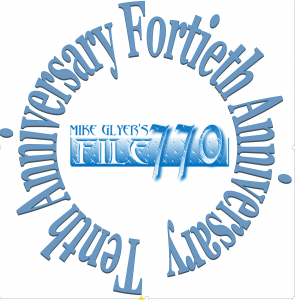 By John Purcell: Sometimes it is hard to believe how long you have been involved with science fiction fandom, or how many issues of a fanzine you have produced, how many conventions you have attended… The list goes on. Whenever I get into this reflective mood, I can’t help but be surprised at how much things have changed while also noting that some things still remain, and even those have changed with the times. Such is the case with File 770.
By John Purcell: Sometimes it is hard to believe how long you have been involved with science fiction fandom, or how many issues of a fanzine you have produced, how many conventions you have attended… The list goes on. Whenever I get into this reflective mood, I can’t help but be surprised at how much things have changed while also noting that some things still remain, and even those have changed with the times. Such is the case with File 770.
When Mike Glyer began producing this fanzine, it was done that tried and true way of being mimeo’d. This was the preferred means of production then; for some fans even now, in 2018, they still type up their stencils, insert art work (a magical process to me: I never mastered this aspect), then ran them off on the mimeograph machine, slip-sheeting away, collating pages, stapling, etc. It is a time-consuming process, but the feeling of satisfied accomplishment when an issue is completed is something else. Thinking back, it’s hard to believe that we actually did it that way every few months or so, or even on a monthly basis. Not only that, keeping it up for any great length of time is a definite head-scratcher.
I used to get File 770 in trade for my fanzines, devouring every issue the instant it plopped into the mailbox. As a news-of-fandom fanzine, File 770 was an informational life-line connecting me with fans and the doings in the science fiction world community. This was how we communicated with each other: trading fanzines, writing back and forth, even gasp! making telephone calls. When computers began coming into our homes, they naturally became a primary means of fannish communication.
Now look at us. Thanks to these changes in communication technology, the sharing of information and news is practically instantaneous. No more waiting a few weeks, months, or – in some cases – years for the next issue to come out to get the scoop on what’s going on in the sf universe. And through it all, File 770 remained as a constant. Like bouncing potatoes and rubber chicken convention banquet food, this fanzine is a fannish institution.
It is pretty darned incredible how easily Mike has changed File 770 formats. I enjoyed getting the dead-tree fanzine back in the day, and now I get File 770 RSS feeds directly to my email account a few times a day! I call that living in Skiffy Land.
Congratulations, Mike, on reaching forty years of File 770. No matter the format, the fanzine/ blog is a huge part of our stfnal lives. Thank you for your devotion to the cause.
[John Purcell is the editor of the zines Askance and Askew, and co-administrator of the Trans-Atlantic Fan Fund.]
Discover more from File 770
Subscribe to get the latest posts to your email.

Congratulations, Mike, on reaching forty years of File 770. No matter the format, the fanzine/ blog is a huge part of our stfnal lives. Thank you for your devotion to the cause.
Hear hear!
I used to do advertising production for a living, and everything I learned about—letterpress, typesetting, making engravings, then making negatives, stripping them, press impositions, veloxes, all sorts of other stuff—are all obsolete and gone.
I used to have various spirit duplicators, a Roneo silk-screen mimeo, rubber cement and thinner, correction fluid bottles. Even bought a Selectric when my zines went offset from mimeo/ditto. All gone.
But the brain that did all that stuff is still here—as is yours! Congratulations on 40 years of your zine, as it’s gone through its various incarnations.
I started doing news stuff in 1961, with a column about upcoming paperbacks, in Jimmy Taurasi’s Science Fiction Times. And since my own Science Fiction Chronicle bit the dust, I’ve been sending out news links and stuff to all sorts of people and places via the Interwebby—including here!
Just think, we’ve become The Krell—sending news instantaneously to anywhere on the planet, for any purpose! Aren’t you glad you got that fannish brain boost?
Part of the surprise is how long that tech hung on, then how quickly it vanished. I was using most of it from the late 1970’s through the early 1990’s (doing publications for MCFI and NESFA); IIRC the first time we did an all-electronic publication was 1999 (although we’d been using DTP to print camera-ready copy for a few years before then — 1991 may have been the last time we did galleys on a typesetter). Automated mimeo hung on even longer, until killed by more compact printers (unlike the room-filler used at the 1996 Worldcon). All these were convenient, but color printing may have been the biggest beneficiary of tech; separations were expensive enough to be a large fraction of the cost of a 1984 memory book (8 color pages in ~70 total), but now everyone has scanners.s
addendum: letterpress, OTOH, was already fading into photolithography (cf negatives) for large-scale work; there’s a 1978 film Farewell, Etaoin Shrdlu built around the last day of hot-metal typesetting at the New York Times. But it’s still around for ~art printing, although not I think as popular as sound recordings on vinyl.
Pingback: AMAZING NEWS FROM FANDOM: 1-14-18 - Amazing Stories